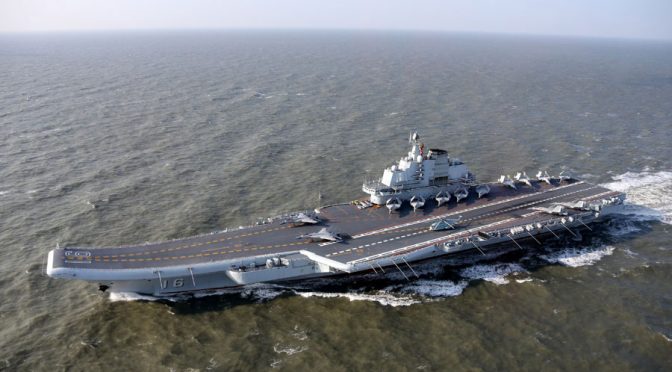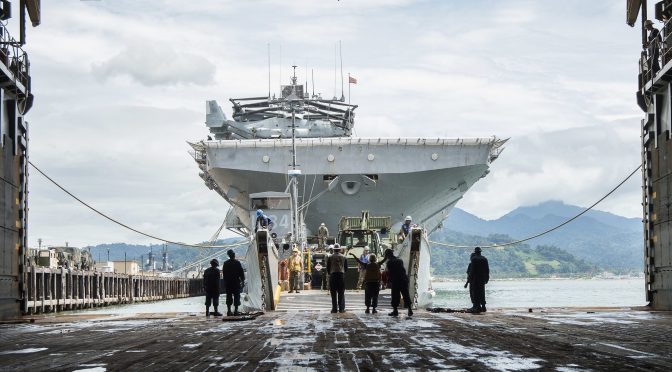By Mina Pollmann
Barry Posen is Ford International Professor of Political Science at MIT, Director of the MIT Security Studies Program, and serves on the Executive Committee of Seminar XXI. Currently on leave, he is presently serving as the Henry A. Kissinger Chair in Foreign Policy and International Relations at the Library of Congress John W. Kluge Center for the 2016-2017 term. In his most recent book, Restraint: A New Foundation for U.S. Grand Strategy (2015), Dr. Posen critiques Liberal Hegemony, the intellectual foundation of current U.S. grand strategy. He presents a bold new vision, a Grand Strategy of Restraint, as an alternative to Liberal Hegemony, and argues that the U.S. ought to focus on pursuing its security through an emphasis on command of the commons, a strategy with a considerable maritime component. CIMSEC spoke with Dr. Posen to get his take on how his arguments can be applied to the world’s emerging strategic defense dilemmas.
Q: Many have suggested that the U.S. is lacking a coherent strategy, including incoming Secretary of Defense James Mattis, who has testified that the U.S. is suffering from “strategic atrophy.” To what extent do you agree with such statements? Is it that the U.S. lacks strategic vision, or that the chaotic nature of the world makes the pursuit of any set strategic goals a fruitless exercise?
A: The United States has had the same strategy since the end of the Cold War. That strategy is Liberal Hegemony. It has two purposes: preserve to the extent possible the immediate post Cold War U.S. power and influence advantage relative to other nation states (dubbed the “unipolar moment”) and promote the spread of democratic forms of governance, market economies, and the rule of law—both within societies and at the level of the international system. This is a revolutionary strategy: it is meant to ensure U.S. security by transforming international politics.
These goals are very ambitious, and confront many moving targets. First, the economic and technological bases for power are diffusing to other countries and to groups, making it inherently difficult to preserve U.S. power and influence relative to them. Second, other peoples may not wish to emulate our forms of governance and economic organization. Nationalism is a strong force, making societies resistant to external tutelage. In some places, there simply is no obvious path to a liberal future. The Middle East is perhaps the most obvious example. There is a strong tension between the preservation of U.S. interests, power, and the spread of democracy. Indeed, there is not even sufficient cause-effect understandings about how to construct democracies.
Q: The U.S. identifies its adversaries in a 4+1 construct: revisionist regional powers such as China and Russia, rogue states that make wild threats and are pursuing or have pursued weapons of mass destruction such as Iran and North Korea, and the condition of widespread extremism and insurgent conflict. Under a Grand Strategy of Restraint, what would be the priorities among these threats?
A: The U.S. needs to think about what are the main threats to its safety, sovereignty, territorial integrity, and to its ability to generate sufficient power to defend these. If China or Russia were to establish hegemony in their regions, that would be a problem for the U.S. Russia is not powerful enough to do so in Europe. China may grow to be powerful enough to do so in Asia. So China is the main problem, though a full court press of containment seems premature.
“Rogue” states are not major problems for U.S. security; they may be problems for U.S. allies and if those allies lack the power to deal with them, then the U.S. can lend a hand. Extremism can be a problem, when it manifests itself in terrorist organizations with global ambitions. But this threat cannot be addressed as we have tried to address it, by reforming societies at the source. Instead the best the U.S. can do is keep pressure on such groups to divert their energies to their own defense, and to put defensive barriers between them and the U.S. This will not stop every problem, but efforts to go to the source, as attempted in Afghanistan and Iraq seem to create new terrorists as fast as the U.S. eliminates old ones.
Q: What is the force structure that a Strategy of Restraint recommends?
A: Restraint focuses U.S. security efforts on the most important threats to U.S. security. And it chooses military forces that are most appropriate to address those threats. Though ‘terrorists of global reach’ are a threat to U.S. safety, the chosen remedy of the last fifteen years—sending large numbers of ground forces to democratize and reform riven societies at gunpoint has proven wildly expensive and largely ineffective. Restraint cuts the ground forces that have been employed for this purpose. Restraint does oppose other great powers who might try to establish hegemony in Eurasia. To maintain the capability to act in Asia, the U.S. must retain command of the sea, and of course sufficient command of air and of space to be able to move forces across the ocean, should that become necessary.
At this time, the most survivable warship in the U.S. inventory is the nuclear attack submarine. When forward deployed, it makes a critical contribution to blocking other great powers access to the open oceans. The aircraft carrier provides a mobile, strategic reserve, to assist threatened allies, and to help sustain command of the air over the open oceans. That said, the carrier is increasingly vulnerable to a range of weapon systems deployed ashore. Thus, in wars with peer competitors, carrier forces must be used in strength and also with care. Except against much weaker states, they can no longer be viewed as airfields that can simply linger offshore for extended periods. U.S. strategic decision makers—civilian and military—must confront the strong possibility that in a serious conflict, some carriers will be lost. The U.S. began WW2 with six carriers; by the end of 1942 four were sunk; and two were badly damaged. Command of the sea does not come cheap.
Q: How important is it for the U.S. to assert itself in the South China Sea? What strategic interests and precedents are at stake? What is the value of freedom of navigation operations there and what other means can the U.S. employ to shape the environment?
A: The U.S. relies on the sea to access the rest of the world, not just for trade, but more importantly to ensure against the rise of a continental hegemon. Thus the U.S. should protect freedom of the seas. States are tempted to bootstrap historical claims and the fine print of the Convention on the Law of the Sea to assert control over quite a lot of sea space. The U.S. should ratify the Convention and continue to assert its right to sail in those waters where others’ claims seem beyond what the Convention allows.
Q: You severely criticize “buck-passing diplomacy” by U.S. allies in your book. Yet there are partners who have been working well with the U.S. (e.g. Singapore) or that the U.S. could be doing more with (e.g. Australia). How can the U.S. better leverage security relationships with such prospective partners? Are there any lessons the U.S. can learn from these relationships that can be applied to the U.S.’s relationships with less forthcoming partners?
A: Most U.S. allies invest much smaller shares of GDP in defense than does the U.S. This arises from their confidence that the U.S. will defend them, and perhaps also their true doubts about the imminence of security threats. They may complain about those threats, but they may not be as concerned as they pretend to be. Australia is one of the allies that under-invests. To the extent that some allies do more than others, this arises from either their proximity to threats, or their history of having been abandoned, or nearly abandoned by past protectors.
There are three lessons for the U.S. First, when your allies tell you they are frightened, ask them what they intend to do about it before offering to solve the problem for them. If the answer is not much, then do not rush to address the problem. Second, make burden sharing a central issue of alliance diplomacy. Third, remind allies that the U.S. is inherently a very secure country. And the U.S. retains command of the sea. We have more options than they do. They need to earn our support.
Q: Donald Trump, on the campaign trail, suggested that the U.S. provide less security to allies unless they paid more, and hinted that Japan, South Korea, and other countries, should acquire nuclear weapons. If Donald Trump sustains pressure on U.S. allies to increase burden sharing, how may these alliances evolve?
A: Eliciting a more equitable sharing of defense burdens requires a strategy. If the President simply sends an irate tweet every now and then, he will accomplish very little.
There are two ways this can go. First, the President can complain and at the same time unilaterally reduce U.S. military contributions to the alliance. If the U.S. simply disengages, my prediction is that U.S. allies, who are quite rich, will learn to defend themselves. But the process could be rocky. This could include getting nuclear weapons. We may wish for prudential reasons to attempt serious reform first. Or, the U.S. can make burden sharing a central issue in the alliances, hinting that our contributions depend on theirs.
The President and U.S. cabinet officials and diplomats must communicate regularly and publicly with allies on this issue. The alliances must set actual concrete military goals. Many of these should be public. The performance of allies must be assessed in public. The Congress must hold hearings on the matter. The press needs to be induced to cover the issue. The allies need to be made to believe that this is very, very serious. If they value U.S. help, they must show that they care about their own defense. They must be made to believe that without evidence to this effect, the alliances will fray, and they will find themselves on their own. Few people remember that this is what the U.S. did with NATO in the late 1970s and early 1980s. It did not work perfectly, but it worked better than anything attempted in recent years.
Q: In the conclusion of your book, you remark that change can happen through one of three ways. The Strategy of Restraint could be adopted through astute politicians listening to proponents of the Strategy of Restraint and having a “eureka” moment; through crisis; or through incremental changes. Is Trump’s election more like a “eureka” moment, or just the first step in a longer process of redirecting U.S. security policy?
A: It is very difficult to read the actual foreign policy orientation of the Trump administration. It does not look to me as if this is a ‘eureka’ moment for the “Restraint” strategy. Instead, this looks a bit like hegemony without liberalism. President-elect Trump has promised to increase U.S. military spending. This is not consistent with Restraint. His appointees seem to be people who wish to militarily confront those states and groups who challenge the U.S. in any way. China and Iran seem to be at the head of the list. Some of his appointees seem hostile to Russia as well. The President-elect seems to wish to do something more aggressive vis-a-vis Al Qaeda and ISIL than the outgoing administration. It is hard to see how this many military confrontations would be consistent with Restraint. With this many under-thought confrontations underway, it is likely that one or more will go awry. The costs will mount, and future administrations will find they have even less public support for a forward grand strategy. This is how I imagine the U.S. could ultimately shift to a more restrained grand strategy.
Barry Posen is Ford International Professor of Political Science at MIT, Director of the MIT Security Studies Program, and serves on the Executive Committee of Seminar XXI. He is presently serving as the Henry A. Kissinger Chair in Foreign Policy and International Relations at the Library of Congress John W. Kluge Center.
Mina Pollmann is CIMSEC’s Director of External Relations.
Featured Image: CAMP FUJI, Japan (Nov. 4, 2016) MV-22B Osprey tiltrotor aircraft return after a long-range raid from Combined Arms Training Center, Camp Fuji, Japan to Marine Corps Air Station Futenma, Okinawa as part of Blue Chromite 2017, Nov. 4, 2016. (U.S. Marine Corps photo by Sergeant Major Michael Cato/released)




